Table of contents
Pistachios are the stone fruits of the pistachio tree ( Pistacia vera) and can be eaten raw or roasted. Chopped or ground, they are often used in pastries, desserts or as a garnish. They are also available in organic quality.
Use in the kitchen
What do pistachios taste like? Pistachio kernels are extremely aromatic. They have a sweet, fruity, nutty, almost almond-like taste. Fresh and unroasted, they have a tender and crunchy texture with a buttery aroma. How do you eat pistachios? They are usually enjoyed as a snack between meals or as an aperitif. Can you eat pistachios raw? While they are mainly eaten raw in the Orient, in Europe they are often roasted and often salted - either unshelled or shelled.
Because of their sweet flavor, pistachios are used in sweets such as pralines, baklava and Mozart balls, as an ingredient in baked goods such as cakes, cookies, cantuccini and other pastries, and for making ice cream and pistachio cream. What do you do with pistachio cream? This cream is suitable as a spread or as a coating for cakes and pastries. Chopped pistachio kernels are also often used to refine desserts (e.g. cakes, mousse, fruit salad) and to decorate cakes. Whether salty or sweet, the green kernels make a great decoration on all kinds of dishes. You can roast the pistachios or add them raw to dishes.
Pistachio kernels (ground) are suitable for making soups, sauces and pesto (often instead of pine nuts) - this tastes delicious over pasta or as a filling for mushrooms on the grill. They also enrich rice dishes and salads - summer salads with avocado, pomegranate seeds or oranges with a mint and lemon dressing are particularly recommended. You can also try our oil-free salad dressing with walnuts (as a vinaigrette with balsamic vinegar) or the oil-free salad sauce with avocado with salad. You can also use the ground pistachios to make energy balls (see recipe below) and vegan cheese in raw food quality.
There is also cold-pressed pistachio oil, which is popular in the kitchen as a seasoning for salads and sauces due to its intense flavor. However, like all oils, this high-calorie ingredient should be used very sparingly.
Raw vegan recipe for pistachio energy balls with matcha
Ingredients (for 10-12 balls): 50 g peeled pistachios (raw, organic), 50 g dates (pitted), 15 g oat flakes, 1 tbsp freshly grated organic lemon peel, 1 tsp matcha powder.
Preparation: Finely grind the pistachio kernels and oat flakes using a blender or hand blender. Add the dates, lemon peel and matcha and mix until finely blended. Form the mixture into medium-sized balls. The vegan energy balls are a great snack to eat on hikes or during other activities where you could use an energy boost.
Vegan recipes with pistachios (raw) can be found under the note: " Recipes that have the most of this ingredient ".
| Not only vegans or vegetarians should read this: Vegans often eat unhealthily. Avoidable nutritional errors. |
Purchasing - Storage
Pistachio kernels can be bought raw in supermarkets such as Coop, Migros, Edeka, whole or partially chopped. You can more often find pistachios in shell, roasted - unsalted or salted - in supermarkets such as Coop, Migros, Edeka, Denner, Volg, Spar, Billa, Aldi, Lidl, Rewe, Hofer and in organic supermarkets (e.g. Alnatura, Denn's Biomarkt) in organic quality. You have a good chance of finding unroasted pistachios in health food stores, organic shops and online shops. In growing countries such as Italy, the USA or Turkey, the pistachio has its peak season between October and November. 17
When buying pistachios in shells, make sure that most of the kernels are slightly open, as this is a sign of ripeness. Unripe kernels are not suitable for consumption. High-quality kernels are whole, with no breaks, discoloration or brown spots. A distinct green color indicates good quality. You can find more information about what else to look out for when buying under the ingredient roasted pistachios.
The shape of the pistachios can also vary; there are round and elongated varieties.
The availability of raw pistachios varies depending on the size of the store, catchment area, etc. If you are interested, click on our recorded food prices for the DA-CH countries (above under the ingredient image). There you will find current prices from various supermarkets and their price development.
Storage tips
Pistachio kernels contain a lot of fat, which makes them rancid. An airtight container and a dark, dry, cool place are ideal, e.g. the pantry. Opened pistachios without shells should be used quickly or stored in an airtight container in the refrigerator for up to 4 weeks. If stored for a longer period of time, they can lose their crispness and green color. You can also freeze the kernels. Their shelf life is extended to about a year in the freezer.
Ingredients - Nutritional values - Calories
The energy content of pistachios (raw) is relatively high at 560 kcal per 100 g, which is mainly due to the fat content of 45 g/100 g. The high fat content is comparable to that of raw cashews (44 g/100 g) and peanuts (49 g/100 g). Raw pistachios have an unfavorable ratio of omega-6 fatty acids to omega-3 fatty acids (LA:ALA) at 49:1. A remarkable 11 g of fiber and 20 g of protein can be found in 100 g of pistachio kernels (raw). 2
Unroasted pistachios are extremely rich in pyridoxine (vitamin B6). The content of 1.7 mg/100g (121% of the daily requirement) is comparable to that of sunflower seeds (1.3 mg/100g). Brewer's yeast contains even more, at 4.4 mg/100g - but you consume much smaller amounts of it. 2
Thiamine (vitamin B1) is also well represented at 0.87 mg/100g (79% of the daily requirement). Raw, unpeeled sesame seeds (0.79 mg/100g) contain a similar amount of thiamine. Macadamia nuts contain slightly more of the vitamin (1.2 mg/100g). 2
In addition to the vitamins mentioned, pistachios (raw) also contain plenty of amino acids. For example, 100 g of raw pistachios contain 0.25 g of tryptophan, which is 101% of the daily requirement. Peanuts have the same amount and cashews contain only slightly more tryptophan at 0.29 g/100g. 2
The complete ingredients of pistachios (raw), the coverage of the daily requirement and comparison values with other ingredients can be found in our nutrient tables. In the article Nutrients explained you will get a detailed insight into the topic.
Health effects
Are pistachios healthy? How healthy are pistachios? There is increasing evidence that regular but moderate consumption of nuts in general - including pistachios - can improve the quality of the diet and promote health. Pistachio kernels contain antioxidant and anti-inflammatory compounds that support cardiovascular health and contribute to a lower risk of heart disease. 3,4,5 These active ingredients are also associated with a reduced risk of cancer and an improved immune system. 5 These are primarily the secondary plant substances, such asbeta-sitosterol, which the USDA states as 198 mg/100g.
Pistachios have a blood-building effect. The iron and copper they contain can counteract anemia caused by iron deficiency. The additional intake of vitamin C- rich fruit and vegetables can enhance this effect. 6 Studies show that regular consumption of pistachio kernels can lead to a reduction in total cholesterol. 4
Do pistachios help you lose weight? Moderate consumption of pistachios can help control body weight due to their satiating effect. Nuts generally help control blood sugar levels. Therefore, it is recommended that diabetics and people at risk of type 2 diabetes include nuts in their diet. 3,4 Adding pistachios, which have a low glycemic index, to foods with a high glycemic index (eg rice, pasta, mashed potatoes) can reduce the glycemic response after eating by 20-30%, according to one study, which can have beneficial effects on blood sugar control. 4
What is the best way to eat pistachios? It is best to eat pistachios unsalted and raw (unroasted), as heat reduces the valuable nutrient content. 5
Dangers - Intolerances - Side effects
Do pistachios have side effects? Nuts, including pistachios, can cause serious allergic reactions and are among the foods that most frequently trigger anaphylaxis. Subjects in a double-blind, placebo-controlled study showed a pistachio allergy when they were allergic to cashew nuts, mainly because pistachios and cashews belong to the same family (Anacardiaceae). 7
Poor hygiene or contact of fresh fruit with the ground can lead to microbial contamination during the traditional pistachio harvest - especially when the pistachios are opened. Drying too slowly outdoors or storing them in conditions that are too humid (often due to excessive humidity) can encourage the growth of mold. The toxic metabolic products of mold, especially aflatoxins, can weaken the immune system, cause genetic damage and promote cancer. 8 Maximum levels and strict controls are intended to limit the placing on the market of food contaminated with aflatoxins. 9
Are pistachios healthy or unhealthy? Despite the good nutrients and bioactive compounds, pistachios should only be consumed in moderate amounts due to the poor LA:ALA ratio (49:1). Walnuts (4:1) and macadamia nuts (6:1) have a much better ratio. In addition, due to their high fat content, regular and often excessive consumption can lead to weight gain. How many pistachios can you eat a day? You should not eat more than 30 g per day. Consider this amount as a guideline and pay attention to your total daily calorie intake.
Folk medicine - natural medicine
In ancient times, the pistachio was a highly valued fruit, especially in the East. It was considered an aphrodisiac and a remedy for melancholy and hypochondria. 10
Ecological footprint - animal welfare
Pistachio kernels have an ecological CO 2 footprint of 3.9 kg CO 2 eq/kg. 18 This is quite high compared to walnuts in shell (0.9 kg CO 2 eq/kg) or peanuts in shell (0.8 kg CO 2 eq/kg). 19
The amount of water required to produce 1 kg of pistachios is 11,363 liters, similar to the amount required to produce 1 kg of walnuts (shelled: 9,280 liters; in shell: 1) or hazelnuts (shelled: 10,515 liters; in shell: 5,258 liters). 20 However, in contrast to walnuts, pistachios are sometimes grown in areas where water scarcity is a major problem, such as Iran. The impact of pistachio cultivation on the environment is correspondingly high, particularly due to the necessary artificial irrigation with water from aquifers, but also due to the use of pesticides. 21
The sustainable use of pistachio residues is currently a research topic. Previous studies show the suitability of pistachio shells for various purposes - e.g. for the production of bio-oil 22, so-called nanopaper, 23 but also in wastewater treatment (of heavy metals). 24
Worldwide occurrence - cultivation
The pistachio ( Pistacia vera) comes from the Middle East. Archaeological records of the early consumption of pistachios in Turkey date back to 7000 BC. Where do pistachios grow? The pistachio trees, which thrive in hot climates, spread from the Middle East to the Mediterranean region. 4 Today, the USA (especially California), Iran and Turkey are the most important growing areas in the world. 3, 4,7
Found in the wild
The real pistachio Pistacia vera and two of its relatives ( Pistacia atlantica and Pistacia khinjuk) occur naturally in Iran. Pistacia vera is the only species of this genus that is grown commercially. The other species are mainly used as rootstocks for P. vera. 1
Cultivation - Harvest
Pistachios are relatively hardy and only thrive in very mild locations. Planting in pots is almost only possible in the winter garden during the cold season. In addition to propagation via seeds, pistachios can also be propagated by cuttings from young shoots. To grow them, you need untreated, fresh seeds that you water for several days before planting. Because they are dioecious, it is important to grow both sexes, because only then can you harvest the small reddish fruits in a few years. In the pot, permeable soil with gravel or Poroton for drainage is recommended, because waterlogging does not suit the pistachio tree, but dryness is hardly a problem for a short time. The soil should also be slightly alkaline, for which lime or sand are suitable. 13
Pistachio trees grow up to 12 m high, but in plantations they are much smaller. Grafting male plant parts onto female plants is also common in plantation cultivation. Pollination occurs through the wind. 14
The pistachio tree only bears fruit every two years (mast years). 9 The climate has a decisive influence on the yield in the mast years. The average daily temperature should be above 36 °C. Although the trees are not considered winter hardy, cool temperatures (around 7 °C) in winter contribute to a high yield. In this case, low temperatures break the bud dormancy, not just the long day conditions. Overly mild winters and heavy rainfall can have a negative impact on the yield. 15
The fruit is usually ready for harvest in September. The conventional harvest of pistachios is done by hand as whole bunches. After the pink fruit shell has been peeled by water, the stone fruits are dried mainly in the sun. In order to achieve a final splitting of the shell, the pistachios are watered again before they are dried for a second time and then sorted and stored. For export, drying takes place in drying plants (approx. 24 hours) and then the stone fruits are stored in silos or processed immediately (roasted and possibly salted). Mechanical tree shakers with collecting devices are also used. 9
Further information
The pistachio tree ( Pistacia vera) belongs to the sumac family (Anacardiaceae). Pistacia vera is called the real pistachio - this is how you can tell it apart from the other species. Botanically speaking, pistachios are not nuts, but stone fruits. The fruit has a fleshy shell, underneath the hard shell with the light green kernel, which is covered with a thin brownish skin. The beige, hard shell makes up about 50% of the weight. 4 There are many varieties that differ in size, shape, color, taste and shell splitting. 14
The pistachio tree ( Pistacia vera) is listed as near threatened in the 2007 Red List of Threatened Species of the International Union for Conservation of Nature and Natural Resources ( IUCN). The IUCN cites overgrazing and excessive fruit use as reasons for the endangerment. 16
Alternative names
Pistachios are also called pistachio kernels, Aleppo nuts or pistachio almonds. Pistachios are also sometimes known as "green almonds " or "laughing nuts" (when the shells are open). Incorrect spellings such as pistachio, pistachio, piztazien, pitazien or postazien creep in.
In English, the pistachio is called pistachio, pistachio nut, pistache, green almond.
Latin synonyms are Pistacia nigricans, Pistacia officinarium, Pistacia reticulate and Pistacia terebinthus.
Other applications
Can the pistachio shells be used? The outer shells of fresh pistachio kernels (mesocarp), which are often considered waste products in the growing regions, have attracted the attention of researchers in recent years. Extracts obtained from the pistachio shells have shown antioxidant, antimicrobial and antimutagenic properties. There is therefore potential for these reddish shells to be used in pharmaceuticals and medicine. 11
Although the wood of the pistachio tree is extremely beautiful, it is rarely used for woodwork. However, it can occasionally be found made into knife handles and musical instruments. 12
Bibliography - 24 Sources
| 1. | Bozorgi M, Memariani Z, Mobli M, Salehi Surmaghi MH, Shams-Ardekani MR, Rahimi R. Five pistacia species (P. vera, P. atlantica, P. terebinthus, P. khinjuk, and P. lentiscus): a review of their traditional uses, phytochemistry, and pharmacology. The Scientific World Journal. 2013;2013:e219815. |
| 2. | USDA United States Department of Agriculture. |
| 3. | Bulló M, Juanola-Falgarona M, Hernández-Alonso P, Salas-Salvadó J. Nutrition attributes and health effects of pistachio nuts. Br J Nutr. 2015;113 Suppl 2:79-93. |
| 4. | Dreher ML. Pistachio nuts: composition and potential health benefits. Nutr Rev. 2012;70(4):234–40. |
| 5. | Healing Foods. Eat your way to a healthier life. Dorling Kindersley: London. 2013: 93. |
| 6. | Pamlona-Roger JD. Heilkräfte der Nahrung. Advent-Verlag: Zürich. 2006: 134-135. |
| 7. | Cetinkaya PG, Karaguzel D, Esenboğa S u. a. Pistachio and cashew nut allergy in childhood: Predictive factors towards development of a decision tree. Asian Pac J Allergy Immunol. 2021;39(1):53–61. |
| 8. | Bayerisches Landesamt für Gesundheit und Lebensmittelsicherheit. Aflatoxine. 2021. |
| 9. | Pini U. Das Bio-Food Handbuch. Ullmann Verlag: Potsdam; 2014: 570-571. |
| 10. | Frutas-hortalizas.com Pistachio nut, Pistachia vera / Anacardiaceae. 2022. |
| 11. | Seifaddinipour M, Farghadani R, Namvar F, Bin Mohamad J, Muhamad NA. In vitro and in vivo anticancer activity of the most cytotoxic fraction of pistachio hull extract in breast cancer. Molecules. 2020;25(8):E1776. |
| 12. | Wood-database.com Pistachio. |
| 13. | Lubera.com Der Pistazienbaum - ein mediterraner Baum für Kenner. |
| 14. | Kashaninejad M, Tabil LG. Pistachio (Pistacia vera L.). Postharvest Biology and Technology of Tropical and Subtropical Fruits. 2011;218–246. |
| 15. | Plantationsinternational.com Pistachios. |
| 16. | Iucnredlist.org Pistacia vera. |
| 17. | Lebensmittellexikon. Saisonkalender Obst- und Importkalender. 2023. |
| 18. | Foodfootprint. Climate Impact CO2 pistachios. 2023. |
| 19. | Reinhardt G, Gärtner S, Wagner T. Ökologische Fussabdrücke von Lebensmitteln und Gerichten in Deutschland. Institut für Energie - und Umweltforschung Heidelberg. 2020. |
| 20. | Mekonnen MM, Hoekstra AY. The green, blue and grey water footprint of crops and derived crop products. Hydrol. Earth Syst. Sci. 2011; 15: 1577-1600. |
| 21. | Bartzas G, Vamvuka D, Komnitsas K. Comparative life cycle assessment of pistachio, almond and apple production. Information Processing in Agriculture Vol 4. 2017; 188-198. |
| 22. | Taghizadeh-Alisaraei A, Alizadeh AH, Ghobadian B, Motevali A. Potential of biofuel production from pistachio waste in Iran. Renewable and Sustainable Energy Reviews Vol 72. 2017; 510-522. |
| 23. | Robles E, et al. Assessment of Bleached and Unbleached Nanofibers from Pistachio Shells for Nanopaper Making. Molecules 26(5). 2021. |
| 24. | Fallahzadeh RA, Tahmasebimoradi M, Soltani Gerdefaramarzi N, Torabidost P, Eslami H. A Review of Strategies for Using Pistachio Waste. Pistachio and Health Journal. 2021; 4 (1): 86-95. |

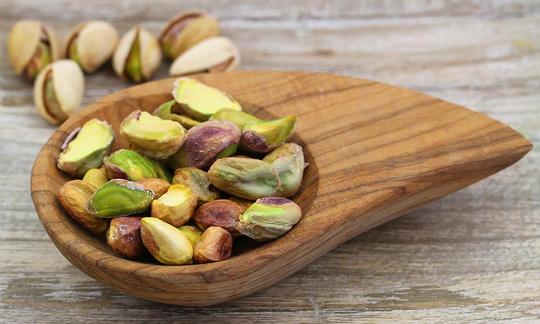

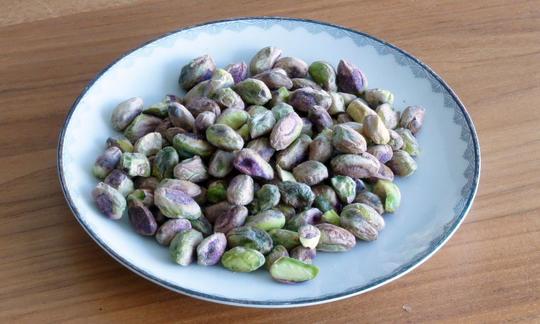

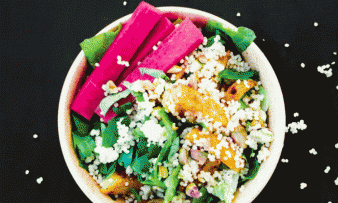
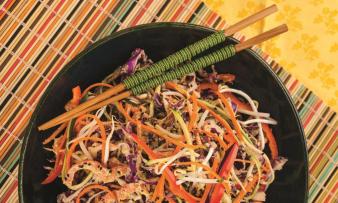
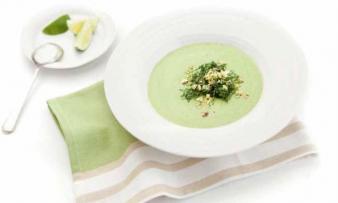





Comments